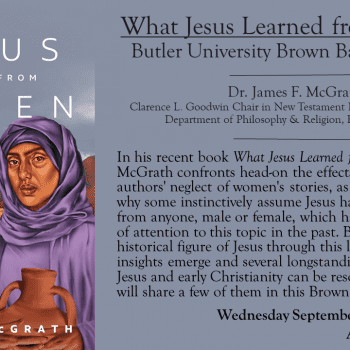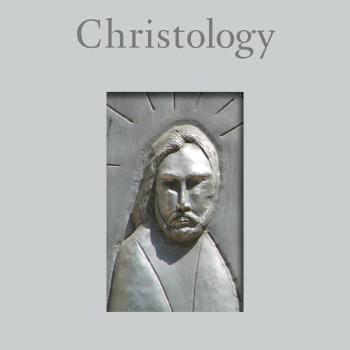Today I am a panelist in an SBL session about Bart Ehrman's book, How Jesus Became God. I thought I would share my notes here both for regular blog readers not attending SBL, for those at SBL who wanted to attend the session and could not, and for those at the session who may find it useful to see my thoughts in writing.
_____
Bart Ehrman’s How Jesus Became God: The Exaltation of a Jewish Preacher from Galilee features all the things that many of us have come to appreciate about Ehrman’s books – a broad overview combined with consideration of important details, clarity to such an extent that a layperson can understand it, and innovative suggestions which make even his books aimed at a popular audience of interest to scholars, and worth talking about at a scholarly conference like this one. I consider it a privilege to have been invited to participate on this panel.
In reflecting on and evaluating the volume, let me begin with those things that I appreciate most:
1) The attention to both the broader Roman and narrower Jewish contexts of early Christianity.
2) The attention to the range of possible meanings of terms like “divinity” not only in non-Jewish but also in Jewish thought. It would perhaps have been useful in this context to mention the concept of “creation out of nothing,” the development of which was probably a major factor in the creation of a sharp dividing line between the one supreme God and all other entities, whether designated as “God” or not. Nonetheless, not everyone is aware that there was blurriness even within a Jewish context, and a range of possible ways of being “divine” even while reserving some forms of reverence for one supreme God alone. And so drawing attention to this is likewise a helpful feature.
3) Although tangential to the book’s main focus, I appreciated Ehrman’s willingness to apply historical reasoning to elements of later works, and to recognize as a result that they may nonetheless preserve older traditions. Examples include the speeches in Acts and the pre-Pauline formulas quoted in his letters. But I am thinking in particular of his treatment of the parable of the sheep and the goats (pp.108-9), which Ehrman argues goes back to Jesus, since later Christians emphasized the need to believe in Jesus as the key to salvation. The point is of course open to challenge, since even Paul emphasizes that those who do certain things will not inherit the kingdom of God, and that those who persist in doing good will receive eternal life, to say nothing of what Matthew (who did not always agree with Paul) says on the topic. And so it would take more detailed discussion of Matthew’s theology to determine whether this specific point is persuasive.[1] But the willingness to not merely dismiss later material distinctive to Matthew illustrates the careful attention to detail that makes Ehrman’s books so valuable and interesting, to scholars as well as the general audience that is their primary target. And it also helps to convey the fact that Ehrman is not approaching this subject from a standpoint of excessive skepticism, which would otherwise be an accusation some might try to use as a means to dismissing the book and what it says. One may disagree with Ehrman’s conclusions, but no one can seriously suggest that he is being unfair.[2]
4) Ehrman’s emphasis on the fact that there isn’t a straight linear trajectory of development in New Testament Christology (p.237). We see this most clearly in the contrast between Luke and John, which compete for last place when it comes to the question of the order in which the Gospels were written. Luke-Acts often seems to accurately reflect some very early, and at times perhaps the earliest, views of Jesus, despite its late date; while John has the only incarnational Christology among the Gospels.
5) This leads in turn to another point that I appreciate – Ehrman’s argument that the traditional terminology of “low Christology” is inappropriate. As Ehrman himself puts it (pp.231-232):
The problem with…the term low Christology – is that it speaks of this view of Christ in a rather condescending way, as if it were an inadequate understanding…I do not think we should overlook just how amazing this view was for the people who first held it. For them, Jesus was not “merely” adopted to be God’s son. That is the wrong emphasis altogether. They believed that Jesus had been exalted to the highest status that anyone could possibly imagine. He was elevated to an impossibly exalted state. This was the most fantastic thing anyone could say about Christ: he had actually been elevated to a position next to God Almighty…This was not a low, inferior understanding of Christ; it was an amazing, breathtaking view.[3]
No book is without its shortcomings, and so let me now turn to a couple of points that I think are open to being challenged.
1) Most mainstream scholars will find uncontroversial the statement that the Synoptic Gospels lack a Christology of pre-existence, while the Gospel of John has one. And so it is understandably Ehrman’s shift on the question of Paul’s Christology that has therefore gotten a significant amount of the attention. Let me make several sub-points related to the interpretation of specific details in Paul’s letters.
- First, the questions of whether Paul thought of Jesus as pre-existent, and whether he thought of him as God, are important to distinguish, even if they are related. Both points have been subjects of ongoing scholarly debate. I won’t attempt to revisit the topic of the Philippians hymn here in detail, since even whole books have a hard time doing justice to the depth and extent of the subject. In relation to 1 Corinthians 10:4, however, I wish to quote Richard Hays’ observation, which I think highlights the problem of treating the typological identification of the rock with Christ as evidence of his personal pre-existence: “Paul’s metaphors should not be pressed. He does not mean, at the level of literal statement, that Moses passed out baptismal certificates or that theologians should debate whether Christ was igneous, metamorphic, or sedimentary.”[4] It seems noteworthy to me that just about, if not indeed every single Pauline hint that Christ may have pre-existed his earthly life, is found in a poetic passage or a symbolic interpretation of the Jewish Scriptures.
- The question of whether Paul thought of Jesus as pre-existent must be followed, if answered positively, by the question of what sort of pre-existence it was. Just as Ehrman highlights an array of ways of being divine, so too there seem to have been a range of possible ways to pre-exist, ranging from ideal existence in the mind and foreordination of God, to something more literal and personal. It should also be noted that, if Paul thought of Jesus as one that pre-existed in heaven, whether as a human soul, the celestial Adam, an angel, a divine hypostasis, or something else, he does not spell these things out in detail in his letters. And so it is also important to remind ourselves that what we are disagreeing about on this subject is less about what Paul wrote, and more about what we think he assumed, and how our own assumptions, and our understanding of Paul’s assumptions, affect our understanding of the meaning of what he in fact wrote.
- Turning to Romans 9:5, Ehrman suggests (p.269) that this text should be accepted as a reference by Paul to Jesus as God. While that is indeed the most natural reading of the grammar of what Paul wrote, many have considered it unlikely that Paul would refer to Jesus as God here when he does not do so elsewhere. Ehrman claims that this argument is circular, since we can only say that Paul does not refer to Jesus as God if we exclude this passage. However, I am not persuaded that the reasoning Ehrman criticizes is in fact circular, or at least, not more so than any interpretation of a text that begins with a text, turns attention to its context, and then returns to the text expecting it to be further elucidated by the process. It is a legitimate question to ask whether it is likely that someone who viewed another person as “God” would refer to him that way explicitly only once, in passing, without further comment or explanation. The probability or otherwise of that must be weighed over against the probability that Paul’s wording here means that Jesus is God, rather than an imprecisely worded exclamation of praise to the one God. Likewise, the fact that Paul elsewhere describes the one God, who exalts Jesus to a position second only to God, as being above all and all in all, makes it seem unlikely that Paul would here call Jesus “God over all.” But in view of what Paul says elsewhere, we still ought to acknowledge that, if Paul meant to say that Jesus is “God over all,” he was implicitly excepting the God who put Jesus over all. And that is still compatible with this being a position of divinity to which Jesus as a human being was exalted. And so it tells us nothing about whether Paul thought Jesus was pre-existent.
- The suggestion that Jesus was thought of as an “angel” is also an interesting one. Here too, it must be asked whether that meant Jesus had been “angelified” by exaltation, rather like Enoch in some literature, or had pre-existed as an angel before appearing on Earth. However, given that this is the sole explicit use of angelos in reference to Jesus, we must consider whether here it has its specific meaning of celestial spiritual messenger, or simply means “messenger.”[5] In context, Paul saying that the Galatians had accepted him, despite his illness, as a messenger of God, even as God’s supreme messenger Jesus Christ, would make perfect sense. And so the question in this instance is once again how to relate what Paul says here to other evidence about his Christology.
- The possibility that our earliest Christian author has more in common with one of the latest Gospels than with the earlier ones raises a number of historical puzzles. And so, for this to make sense, we need to come up with a plausible explanation of why one or more Christians very early on began to speak of Jesus as pre-existent, and why others did not follow suit. This is not a criticism of Ehrman’s book per se, but is rather an indication of where its treatment of this subject for a popular audience leads to areas that deserve fuller exploration and discussion in greater detail by Ehrman and/or others who find his interpretation of Paul persuasive. One possible avenue for exploration is that the Similitudes of Enoch, with their depiction of the Messiah as pre-existent and already filled with the wisdom of God, may have influenced Paul and provided the framework for his view of Jesus.[6] But that work also influenced Matthew, who nevertheless fails to depict Jesus as pre-existent. And so the influence of the Similitudes alone seems inadequate to explain the differences. Could it have been Paul’s desire to contrast decisions by Adam and Christ that led to the first step being taken in the direction of understanding the pre-existence of the Messiah literally? This and other possibilities need to be revisited.
2) Let me turn now more briefly to a second point at which I found Ehrman’s case less than compelling, namely his treatment of Jesus’ burial, or lack thereof. I felt that Ehrman blurred the distinction between being denied burial altogether, and being denied a decent burial, in a manner that is unhelpful. The Gospel of Mark, read on its own terms, suggests that Jesus was given a dishonorable burial, as scholars like Raymond Brown, Byron McCane, and Craig Evans have suggested. It would have been good to see direct interaction with their cases, and perhaps also with the considerations which have apparently led John Dominic Crossan to move away from his own earlier stance that Jesus’ body was probably devoured by dogs. Jewish concern for burial even of crucified criminals is noted by Josephus. And were the application of the Jewish law regarding burial before sundown consistently and regularly prevented by Roman authorities, we would expect Jewish sources to mention this. The burial of Jesus in a grave for criminals would not have been “act of mercy” (as Ehrman refers to it), but merely a scrupulous application of what Torah required. It is only in some later sources that Joseph of Arimathea is turned into a disciple who acts to honor Jesus, and when such changes are made, the tomb and other details are also made more honorable. There is also a relevant piece of non-textual evidence: The fact that local Christians preserved a memory about the place where Jesus had been buried, even after the spot was covered by a stone platform connected with a temple of Aphrodite, and which by then was within the city walls, and which when uncovered revealed an abandoned limestone quarry (“the stone the builders rejected”) with multiple burial niches (indicating that this was a “graveyard” rather than a private tomb) seems to involve too many points of agreement with the meaning of Mark’s account, as understood by historical scholars but obscured by subsequent tradition, for this to be a coincidence. We do know as well from archaeological evidence that Jesus was not the only victim of crucifixion to be buried. I suspect, given the evidence, that there was an exception for the Jews to observe the demands of their ancestral law concerning burial, much as there was with respect to idols, rather than Jesus and a small handful of others having been granted individual exemptions from the common Roman practice. Nonetheless, Ehrman’s emphasis that Jesus was not given a decent burial may helpfully draw attention to the fact that the historical evidence suggests precisely what later Gospel authors sought to obscure and even directly deny, namely that Jesus was given a dishonorable burial without the spices and other actions that his followers felt he deserved. The question of why the Gospel authors felt the need to undo the indignity of how Jesus was buried in their storytelling, despite believing that God had acted to undo Jesus’ shameful burial, remains puzzling to me, and so here too I hope that Ehrman’s highlighting of this point will bring more attention to bear on the question, leading at the very least to interesting and creative discussion, if not clear answers.
I hope that these thoughts which I have shared will indicate both my appreciation for Ehrman’s book, which I think brings mainstream scholarship into the public consciousness in important ways, while also providing food for thought for scholars working on early Christology as well. This panel’s existence already testifies to this, but I trust that by the time our conversation here today is over, that testimony will be further reinforced by the evidence of the engagement which the book inspires and provokes among us.
[1] As someone who came to the academic study of the Bible out of and through a conservative Christian context, as did Bart Ehrman, I sometimes feel that that way of reading the text sometimes still shapes his understanding of New Testament works.
[2] I deliberately delayed reading the response volume edited by Mike Bird, How God Became Jesus, to avoid having my thoughts about the book colored by the criticisms of others before I had formulated my own thinking. I am frankly astonished that Ehrman’s view that the sources are problematic, but willingness to nevertheless see where there are strong arguments for the authenticity of some material, is characterized in the book as inconsistency rather than a balanced application of historical methods (see for instance p.49).
[3] Ehrman continues: “For this reason, I usually prefer to speak of it…as an exaltation Christology.” It is ironic that Mike Bird nonetheless insists that “Ehrman’s view of Jesus is low, so low in fact that it could probably win a limbo contest against a leprechaun” (How God Became Jesus, p.11).
[4] Richard Hays, Echoes of Scripture in the Letters of Paul, p. 91.
[5] So F. F. Bruce, also Theodor Zahn and Sam K. Williams. Either way this statement will stand out within Paul’s letters, since there is no clear usage by Paul of angelos in reference to human messengers, although that meaning has been proposed for 1 Cor. 11 (see for instance Alan G. Padgett, ‘Paul on Women in the Church: The Contradictions of Coiffure in 1 Corinthians 11.2-16’, JSNT 20 (1984) 69-86); but likewise there is no other instance of Jesus being called an “angel.” It is also to be noted that here it would indeed be circular to suggest that Paul could not mean “messenger” here because he does not use angelos with that meaning elsewhere, since the word genuinely means both and so would be natural to use in either sense.
[6] See further James A. Waddell, The Messiah.
_____
Of related interest around the blogosphere, see David Capes' post from a while back, in which he says Paul splits the Shema to include Jesus within it, and thus within the divine identity. I've blogged previously about a number of aspects of that topic.
Also see Andrew Perriman's post on the Christology of the Synoptic Gospels, and another on Jesus as the one who pours out the Spirit of God. Related to that is Mike Bird's mention of a lecture by Richard Hays, about the depiction of Jesus as divine in the Gospels. Dustin Smith and Dale Tuggy recently talked about pre-existence in the Gospel of John. And finally, note as well that Mike Heiser has created a website dedicated to the theme of “two powers in heaven.”













